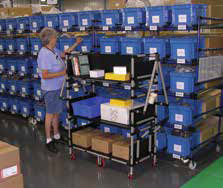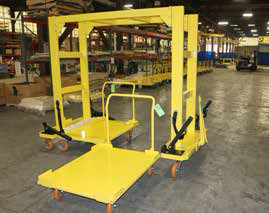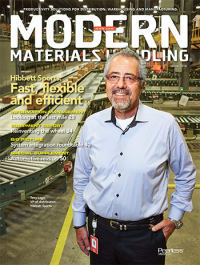Casters, carts, and tuggers: Reinventing the Wheel
Moving product through a warehouse or distribution center often comes down to the basics: casters, tuggers and carts. Innovations in these simple solutions are increasing ergonomics, productivity and safety for workers on the floor.
Latest Material Handling News
2024 Intralogistics Robotics Survey: Robot demand surges Autonomous mobile robots (AMRs) on a mission K.Hartwall and its Australian distribution partner, Retailquip, join forces Pramac partners with BlueBotics to launch line of ANT driven mobile robots Mitsubishi Logisnext partners with Jungheinrich to introduce Rocrich AGV Solutions More AGVs and AMRsWho says you can’t reinvent the wheel? While you may think of casters, carts and tuggers as materials handling 101, relying on wheels as much as anything else, OEMs of these shop floor stalwarts continue to innovate. Suppliers are designing new products that can make operations more efficient, reduce noise levels and improve ergonomics and safety with products that require less effort as operators transport goods from warehouses to assembly lines and then to finished goods warehouses.Here are some of the ways they continue to reinvent the wheel.
Casters withstand heavy loads and misalignment
For manufacturing facilities through out the United States, a rise in product volume, along with an increase in demand for same-day or next-day shipments, can be a double-edged sword. On the one hand, an uptick in volume and demand will likely lead to a surge in net profits. On the other hand, it can also lead to a higher risk for injuries as distributors move heavier loads and move them more frequently.
To lower this risk, end users are seeking specially designed casters that can withstand the weight of high product volumes while also decreasing the sounds the carts make as they move through the plant and warehouse. After all, noise (particularly at high levels) is another work hazard issue that manufacturers are striving to decrease on the factory floor.
- Motorized industrial casters. To improve the ergonomics of moving a cart within a manufacturing process, some manufacturers have added motors to their caster wheels. For the most part, this method is effective. Yet, one primary issue remains—integrating a caster into a motorized system can be complex. A shaft connects the motor to the wheel, resulting in a design that is not only complicated, but also difficult to apply inmost applications. The wheel has to be driven by a shaft, and, unfortunately, this shaft design is difficult to integrate in the function of the cart, generally leading to a costly, intricate system. There is another option: The integration of quarter or half horse power electric motor with an industrial caster, but without using a shaft. Doing so simplifies the design and integration of the product into the system. This all in-one caster can move loads of up to 6,000 pounds at a top speed of 5 miles per hour and be safely controlled by a control system designed specifically for the application. “The motorized industrial caster reduces the human force required to move a heavy load (3,000 pounds or less) to literally zero force,” says Bill Dobbins, CEO of Caster Concepts. “By not requiring any exertion of energy from the operator, a motor-powered solution decreases the risk of injuries while also increasing productivity, as fewer operators are needed to move heavy loads.”
- Swivel casters. Traditional carts have two swivel casters that are located at the steering end and two rigid casters at the opposite end. When carts are stopped and then maneuvered into a new position, the swivel casters are often pointed in various directions. As a result, it may be difficult to restart the movement of a stationary cart, especially if the casters are pointed in the opposite direction. A new swivel caster featuring a patented “under the hood” bearing raceway design significantly reduces the manual forces necessary to begin moving parked carts. “The key technology is the swivel construction inside the caster,” explains Mark Lippert, vice president of marketing for Hamilton Caster. “A conventional caster has a perfectly circular ball race that rotates around a stationary center. “The new caster rotates around two separate vertical axes. This rotation minimizes the lockup tendencies of the conventional casters that can tend to ‘fight’ each other.” Consequently, it takes less human effort to begin moving a parked cart, resulting in a potential reduction of long-term absences due to injuries. In addition to injury prevention, operators will also save another valuable resource—time, thereby improving on the-job efficiency.
Carts improve delivery times
In the past, forklift operators were only able to transport one container of goods at a time to the production line. Once they unloaded a container, they had to return to the warehouse to refill their empty container before they could distribute products to another position on the production line.
By using a tugger and cart system, operators can unload products and replace empty containers on the production line multiple times in a single pass. This approach decreases the potential for employee injuries, improves ergonomics (primarily since operators have more time to focus on other projects) and reduces noise since the tuggers and carts are often only transported to production lines once. As a result, carts are becoming more specialized, especially as their popularity continues to increase in nearly every industry that manufactures products.
- Custom-built carts. Regardless of the industry in which they work, manufacturers must be prepared for constant variations in product mix and volume. To fully optimize space for heavy or oddly shaped loads, manufacturers are increasingly purchasing custom-built carts, potentially the most flexible carts available in today’s market. Not only can they be built according to the purchasers’ unique capacity, form and function needs, they can also be modified or even disassembled, and then rebuilt into new types of structures.
As a result of their flexibility, custom built carts will transport virtually any type of product. For instance, the carts can be extended and widened for bulky loads or configured for the movement of smaller, more fragile products, as padding and other forms of protection can be added when necessary. Furthermore, since they are lighter in weight than stock carts, multiple custom-built carts can be towed at once, rather than just one at a time.
 “By using custom-built carts, manufacturers can improve transportation efficiency, as they reduce the number of trips necessary to move parts to assembly lines and products to warehouses and distribution centers,” says Keith Soderlund, vice president of sales for Creform. “Manufacturers will also save money on equipment and personnel since less tuggers will be required to convey products.”
“By using custom-built carts, manufacturers can improve transportation efficiency, as they reduce the number of trips necessary to move parts to assembly lines and products to warehouses and distribution centers,” says Keith Soderlund, vice president of sales for Creform. “Manufacturers will also save money on equipment and personnel since less tuggers will be required to convey products.” - Mother/daughter carts. “Mother” and “daughter” carts are another innovation that improves efficiency. Smaller daughter carts are designed to fit within the frame work of the larger mother cart. Once they are placed inside, the daughter carts are locked into place and the mother/daughter combination is tugged as one unit.
 Prior to the release of mother and daughter carts, a train of multiple carts would need to be uncoupled each time an operator stopped to deliver a part or product. The carts were then recoupled, a lengthy process that negatively affected the productivity of transporters, as well as manufacturing plants as a whole.
“But, by using a mother cart, the smaller daughter carts can be unloaded and loaded in seconds by unlocking and locking them back into the larger framework,” says Ed Brown, CEO of Topper Industrial.
Typically, mother carts can incorporate two carts in a one-to-one scenario; however, if they prefer, operators can also load one daughter cart into the mother cart, especially if they are transporting bulky items. Of equal importance, the mother cart concept can feature a C-frame, an E-frame or an open frame style, so the daughter carts can be removed from either side.
“Mother carts are quite flexible as their design can be retrofitted as dunnage size requirements change,” says Terry Parmelee, vice president of sales and marketing for Kinetic Technologies (K-Tec).“They can even be converted to four-wheel steer, an option that is sometimes necessary, particularly when factories’ floor aisles dictate extremely tight turning.”
Prior to the release of mother and daughter carts, a train of multiple carts would need to be uncoupled each time an operator stopped to deliver a part or product. The carts were then recoupled, a lengthy process that negatively affected the productivity of transporters, as well as manufacturing plants as a whole.
“But, by using a mother cart, the smaller daughter carts can be unloaded and loaded in seconds by unlocking and locking them back into the larger framework,” says Ed Brown, CEO of Topper Industrial.
Typically, mother carts can incorporate two carts in a one-to-one scenario; however, if they prefer, operators can also load one daughter cart into the mother cart, especially if they are transporting bulky items. Of equal importance, the mother cart concept can feature a C-frame, an E-frame or an open frame style, so the daughter carts can be removed from either side.
“Mother carts are quite flexible as their design can be retrofitted as dunnage size requirements change,” says Terry Parmelee, vice president of sales and marketing for Kinetic Technologies (K-Tec).“They can even be converted to four-wheel steer, an option that is sometimes necessary, particularly when factories’ floor aisles dictate extremely tight turning.”
Tuggers improve employees’ safety and productivity
In recent years, manufacturers have gone fork free, replacing forklifts with tuggers in production areas and reserving forklifts on shop floors for maintenance. Since tuggers do not have extensions, they can be turned more easily in tight corners and driven in narrower aisles. In the past, such turns and passageways were considered unsafe for operators, as fork extensions could potentially be driven into warehouse or distribution center storage shelves.
As more manufacturers transition to tuggers, two options are becoming increasingly popular: Tugger automatic guided vehicles (AGVs) and electric tow tractors.
- Tugger AGVs. Tuggers are considered one of the most economical types of materials handling vehicles on the market, mainly since they can move multiple loads—upwards of six on each delivery—per vehicle. Some, known as tugger AGVs, are also completely controlled by computers, so that they can be navigated without drivers, offering operators an opportunity to perform other duties on the production floor. To improve the safety of employees as loads are transported, tugger AGVs path so equipped with laser-based, obstacle in the AGV’s path, so that it does not endanger the safety of employees or damage products or plant equipment. “These sensors typically include ‘warning’ and ‘stop’ zones. As an AGV approaches an obstacle, it will enter the ‘warning’ field of the sensor,” says Mark Longacre, marketing manager for JBT Corp. “The AGV will then slowdown, flash warning lights and sound an audible warning alarm. As the AGV slowly approaches the obstacle, it will then enter the ‘stop’ field, and the AGV will stop.” According to Longacre, “the sensors are programmable so that the ‘warning’ and ‘stop’ zones can be larger in wide open areas and smaller in tight areas. The selection of the appropriate safety zone size and shape is done automatically, based on vehicle speed and direction, so that the AGVs will safely operate at proper speeds, depending on the areas they are traveling through.”
- Electric tow tractors. To improve employee productivity, some electric tow motors are now being manufactured with AC drive systems that supply electricity directly to motors, eliminating the necessity for commutators (which reverses the direction of currents between rotors and external circuits) and motor brushes, each of which requires regular maintenance. The AC drive systems also control the speed of electrical motors, so that the tractors can accelerate faster. Some electric tow tractors also have automatic shut-off features so that the vehicles will not operate after 30 minutes of inactivity. By preventing unnecessary battery drain, operators can improve their productivity, as they will spend less time recharging their tractors’ batteries. Between their fast acceleration, lack of maintenance requirements and prolonged battery charge, electric tow tractors offer a variety of features that improve operators’ efficiency. “By keeping the end user in mind, electric tow tractors will continue to improve the operations of various industries, as products are transported from assembly lines to distribution centers, ”says Mark Faiman, product manager for IC, AWP and GSE products at Toyota Material Handling.
Companies mentioned in this article:
Caster Concepts
Creform
Hamilton Caster
JBT Corp
Kinetic Technologies (K-Tec)
Topper Industrial
Toyota Material Handling.

Article Topics
AGVs and AMRs News & Resources
2024 Intralogistics Robotics Survey: Robot demand surges Autonomous mobile robots (AMRs) on a mission K.Hartwall and its Australian distribution partner, Retailquip, join forces Pramac partners with BlueBotics to launch line of ANT driven mobile robots Mitsubishi Logisnext partners with Jungheinrich to introduce Rocrich AGV Solutions CaPow’s power-in-motion solution eliminates charging downtime Conveyco unveils All-Temp AMRs that can move between frozen, chilled and ambient warehouses More AGVs and AMRsLatest in Materials Handling
Registration open for Pack Expo International 2024 Walmart chooses Swisslog AS/RS and software for third milk processing facility NetLogistik partners with Vuzix subsidiary Moviynt to offer mobility solutions for warehouses Materials Handling Robotics: The new world of heterogeneous robotic integration BSLBATT is looking for new distributors and resellers worldwide Lucas Watson appointed CSO for Körber’s Parcel Logistics business in North America Hyster recognizes Dealers of Distinction for 2023 More Materials HandlingAbout the Author
Subscribe to Materials Handling Magazine

Find out what the world's most innovative companies are doing to improve productivity in their plants and distribution centers.
Start your FREE subscription today.
April 2024 Modern Materials Handling

Latest Resources











